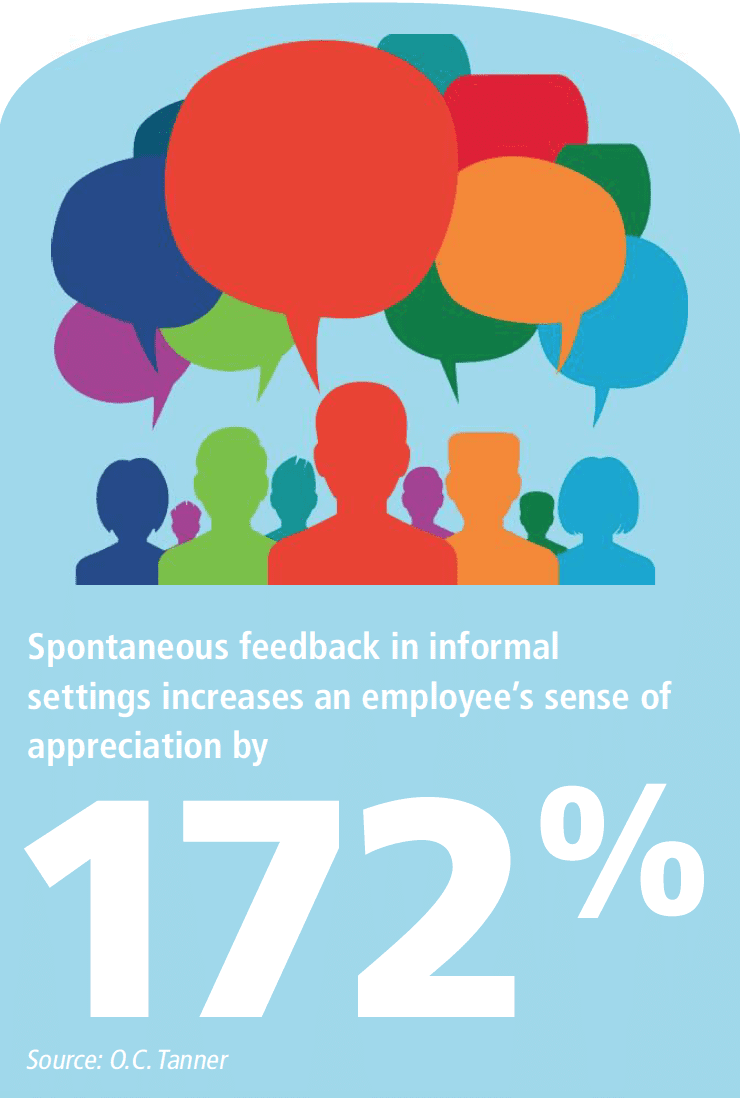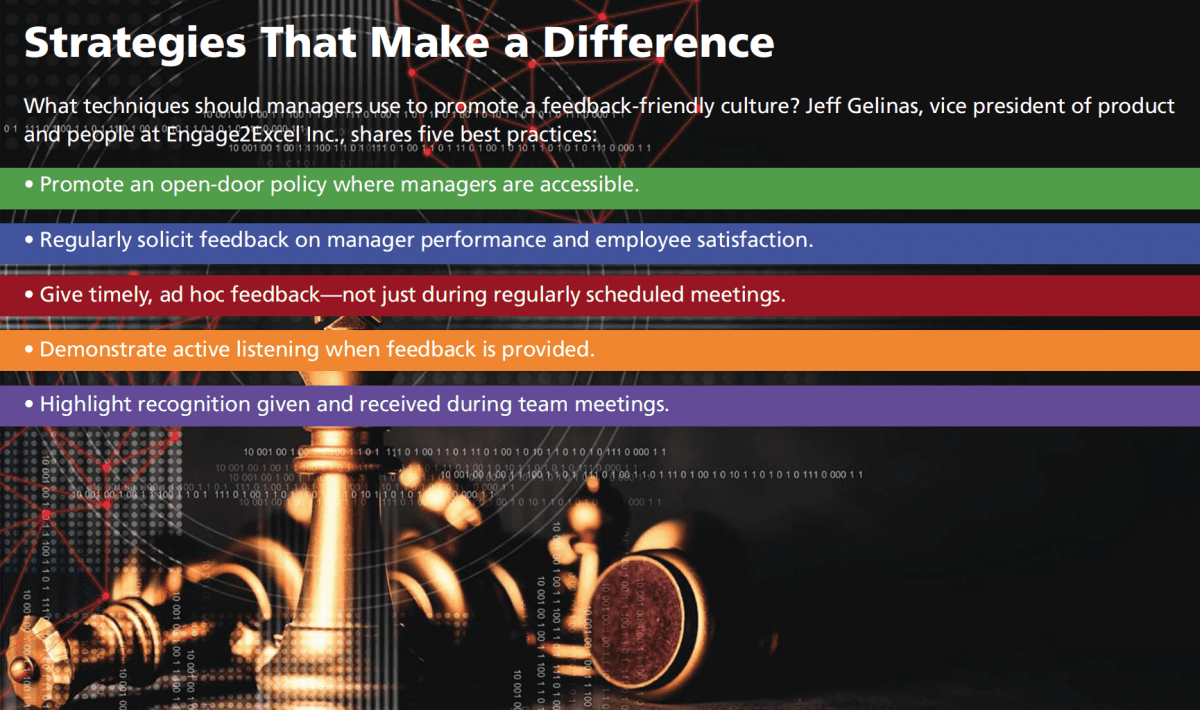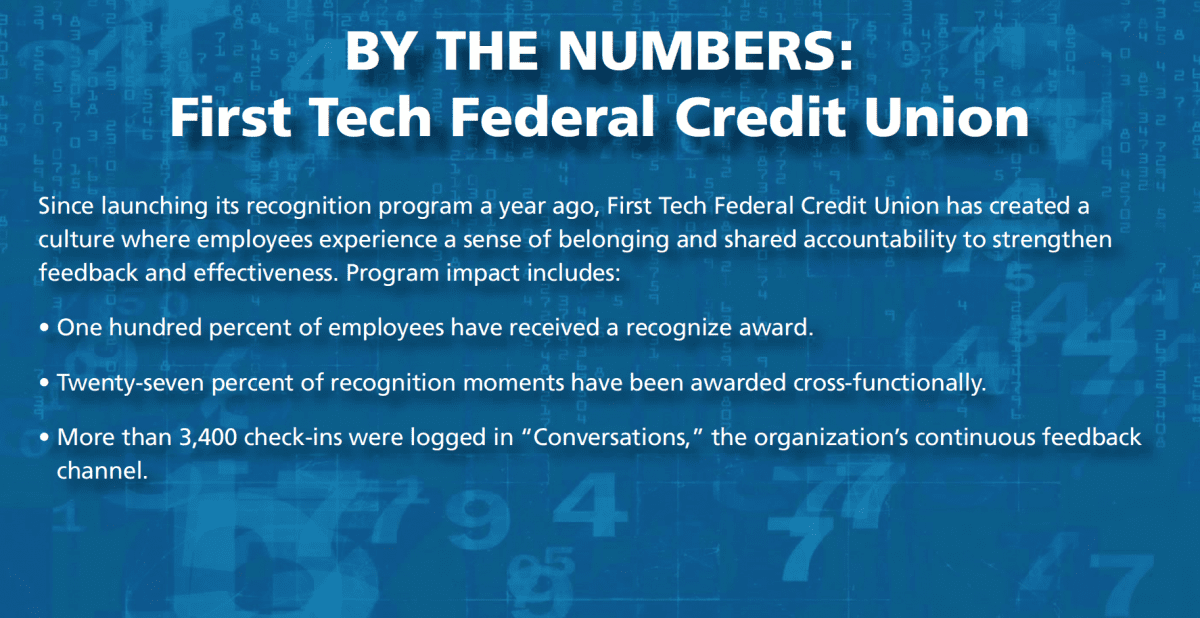Empower employees by embracing a feedback-based culture.
By Marta Chmielowicz
What is a feedback-focused culture? It’s one where all employees feel confident voicing their perspectives. One where relationships are grounded on trust and respect. One where positivity and openness are the norm, and even people who aren’t skilled in giving or receiving feedback are happy to participate.
This type of culture is embraced by leading HR software provider Paycor. “We have what I would call a ‘by the people, for the people’ relationship with our employees,” says CHRO Karen Crone. By making leaders accessible and giving employees ample opportunity to provide feedback, Paycor’s workforce has adopted a forward-thinking growth mindset and a better understanding of the company’s priorities and business goals.
According to Jeff Gelinas, vice president of product and people at Engage2Excel Inc., this approach has multiple benefits: better organizational alignment resulting from frequent communication, improved engagement, and increased productivity.
But how can it become a reality? Chary Krout, senior vice president of HR at First Tech Federal Credit Union, says that cultivating a feedback-centered culture goes beyond surveys and meetings with management. “A first step is for employers to foster an atmosphere where employees have greater trust and feel empowered to give and solicit feedback,” she explains. “While it’s a leader’s responsibility to ensure these conversations and check-ins are ongoing throughout the year, employees can take the driver’s seat to their performance and development.”
There are other best practices organizations can follow to create such an atmosphere. Paycor’s approach involves a number of different programs and initiatives:
- Regular meetings with leadership. According to Crone, the company ensures that employees engage frequently and directly with their leaders by hosting monthly and quarterly meetings. “Pulse” business updates run monthly and feature a live webcast with an employee-driven agenda, while “the Leads” quarterly meetings are led by executives at the director level and above and focus on larger business strategy.
“It’s really an opportunity for employees to lean in on our strategy, so we take a deeper dive on an element of our strategy and let employees reflect on it and understand how the leadership team got to that decision,” she explains. “Our perspective is that when people understand the direction, health, and key priorities of the business, they ask questions about those things and there’s more of a framework for them to reflect on. That gives you a chance to take action on their feedback instead of having feedback that’s not connected to your business.”
These meetings also give leaders an opportunity to address the ways that the business is integrating past feedback into its strategy. By being transparent about plans and intentions, leaders help employees feel heard and respected.
- Field visits. Paycor’s leaders also engage with their employees through regular field visits to the company’s various branches. These visits include a town hall with open question sessions followed by a social event where executives can get to know their people personally.
- Employee resource groups. Self-managed employee resource groups are another way that Paycor empowers employees and makes their voices heard throughout the organization. For example, a young professionals group works to develop training programs and shape its own self-development through a program called “Accelerate.” Another community partners group leverages employee feedback to develop community improvement efforts and initiatives that the entire company can get behind. These are examples of the company’s “for the people, by the people” philosophy in action, says Crone.
- Debriefs after major initiatives. “Another thing we’ve done is we try to steal a page from agile,” Crone says. “One of the agile messages is making sure you have a post-mortem after your agile window. We make sure we have debriefs around a lot of our major initiatives -that’s an example of everyone coming into the room with the same voice. Everybody has a chance to weigh into what went well and what didn’t go well.”
Pulse surveys are used at the end of onboarding, training, and any other company initiatives to instantly capture an authentic reading of employee perceptions and ideas. By building a feedback loop mechanism into everything it does, Paycor assures employees that their opinions are valued, improving engagement while collecting valuable data about the employee experience.
Feedback Transforms Performance Management
A feedback-based culture also has a positive impact on the performance management process. When organizations are open to hearing feedback, they become accustomed to giving it more frequently as well.
“Our research demonstrates that implementing a continuous performance management program is an effective strategy to cultivating a feedback-rich environment,” says Gary Beckstrand, vice president of the O.C. Tanner Institute. “This strategy includes multiple methods of conversation and development: one-to-ones, quarterly reviews, and annual reviews. One-to-ones are deliberate conversations that include feedback, celebrations of micro-victories, and guidance. Organizations that want to institutionalize feedback should start with ensuring one-to-ones are occurring. From there, they should ensure their strategy integrates quarterly and yearly reviews.”
According to Crone, Paycor leverages these performance management strategies and provides ample opportunity for two-way feedback between managers and employees. After learning that employees were not satisfied with infrequent performance reviews, the organization developed “Connect” sessions that occur four times a year. “Connect Light” sessions check in on performance while “Connect Heavy” sessions dig deeper into employee goals and development progress. These quarterly performance conversations promote ongoing feedback and coaching that encourages constant development and performance improvement. And they are hugely popular: Crone reports a 92 percent participation rate.
Employees also receive the opportunity to comment on their managers’ performance through an annual coaching index of 15 to 20 behavioral-based questions. Based on this feedback, managers receive a performance score that helps compare skills and identify points of improvement.
“So often in performance management systems, it’s not unusual for the boss to tell you how you’ve done or for the manager to just parrot feedback that employees wrote about themselves,” explains Crone. “What we’ve tried to do is create balance in the relationships. We allow the employee to have a voice about what they’ve accomplished that is not seen by the manager, and allow the employee and manager feedback to stand side by side. Then when they’re together in their one-on-ones, they’re talking about the differences or gaps in perspective, or validating a shared perspective.”
Recognition’s Role
Creating a positive, trusting, and feedback-friendly workplace is a difficult task, but an effective recognition program can help. “When employees offer ideas, it’s important to listen to those ideas and show appreciation -and not just for the best ideas. By creating a culture of recognition and appreciation, employees feel more respected, care more, work smarter, and stay longer,” Gelinas says.
First Tech Federal Credit Union leverages a tech-driven recognition solution from Globoforce that enables frequent and meaningful feedback, and cultivates deeper connections across the organization. The company’s strategy includes social recognition, frequent check-ins, and employee-led conversations that strengthen workplace relationships.
“We have found that one of the major benefits of promoting recognition and continuous feedback at work is that it builds a deeper sense of belonging and trust across our entire company,” says Krout. “By recognizing people for their work in timely and meaningful ways that align with the goals and values of the organization, employees will feel more engaged and encouraged to speak up.”
In fact, formal recognition increases an employee’s sense of appreciation by 355 percent, says Beckstrand. And it doesn’t end there -spontaneous feedback in informal settings increases an employee’s sense of appreciation by 172 percent. By consistently providing recognition and then amplifying it throughout the organization, Beckstrand explains that managers can build and support employee confidence while helping workers feel more connected to their organization, their leaders, and their accomplishments.
Another strategy to better enable a feedback-rich organizational culture is manager training. “You have to get managers comfortable with employees having a voice,” says Crone. “Getting comfortable with letting people plan and execute on their role and adopting a coaching or mentoring role provides a richer environment for feedback.”

Krout says First Tech Federal Credit Union didn’t go the training route but started slow instead. “We didn’t know where to start with training on providing constructive feedback, so we started small with recognition while piloting the conversations tool with 50 percent of our workforce. To our surprise, the vast majority of leaders and employees in our pilot were having meaningful conversations and recognition,” Krout explains.
By implementing these best practices and actively providing opportunities for both employees and managers to share feedback, business leaders will be well on their way to creating a self-sustaining organizational culture of growth, awareness, and transparency.

















